Robot mowers are quickly gaining popularity for domestic lawn mowing, and it’s easy to see why.
These mowers are completely autonomous, which means they mow your lawn independently, based on your initial programming and their own smart scheduling.
In this guide, I’ve shared all the pros and cons you should consider when deciding whether a robot lawn mower is worth it for you.
✅ Key Takeaways:
The key advantages of robotic lawn mowers are that they save time and effort because they mow independently, they’re cheaper to run than most other mower types, they mulch grass and cut frequently which is better for your lawn health, and they’re quieter than other mowers.
The disadvantages of robot mowers are that they’re expensive upfront, they require a complex setup, they’re high-maintenance, they’re hit-and-miss with edge-cutting, and they’ll struggle to mow over leaves, twigs, and other garden debris.
Table of Contents
✔️ Robot Lawn Mower Pros
Here are some of the biggest benefits of electric mowers compared to other mower types:
⏰ Save Time And Effort
The most notable benefit of a robotic mower is that it eliminates the need for manual mowing.
Once you’ve set up and programmed a robot lawn mower, it’ll be able to mow your lawn autonomously, with no further input from you.
That means the mower will establish a mowing schedule, mow your lawn according to this schedule, and return to its docking station for charging, entirely independently.
Many robotic lawn mowers have Bluetooth apps, so you can monitor your mower’s performance and make adjustments if necessary. Otherwise, you can simply leave your mower to it, with no physical mowing effort required.
Owning a robot mower can save you hours of time over the grass growing season. You’ll no longer have to dedicate your Sunday mornings to mowing your lawn, so you can spend more time relaxing, catching up with family, or taking trips away, knowing that your grass won’t become overgrown in the meantime.
Like traditional lawnmowers, robotic lawn mowers require cleaning to prevent a buildup of grass and dirt on the mower’s undercarriage, but this simple task is far quicker and easier than the entire ordeal of manually mowing your lawn.
💰 Cheaper To Run Than Other Mowers
Robotic mowers are also cheaper to run than traditional mower types.
These mowers have a rechargeable battery, and they’re much smaller than conventional lawn mowers, so their energy consumption is lower.
Corded electric and petrol-powered mowers use more energy in comparison, and their running costs are up to double the running costs of a robot lawn mower.
Robotic lawn mowers are also better for grass health (see below), helping you to sustain green, thick turf without having the additional spend of commercial lawn fertilizers and grass seed.
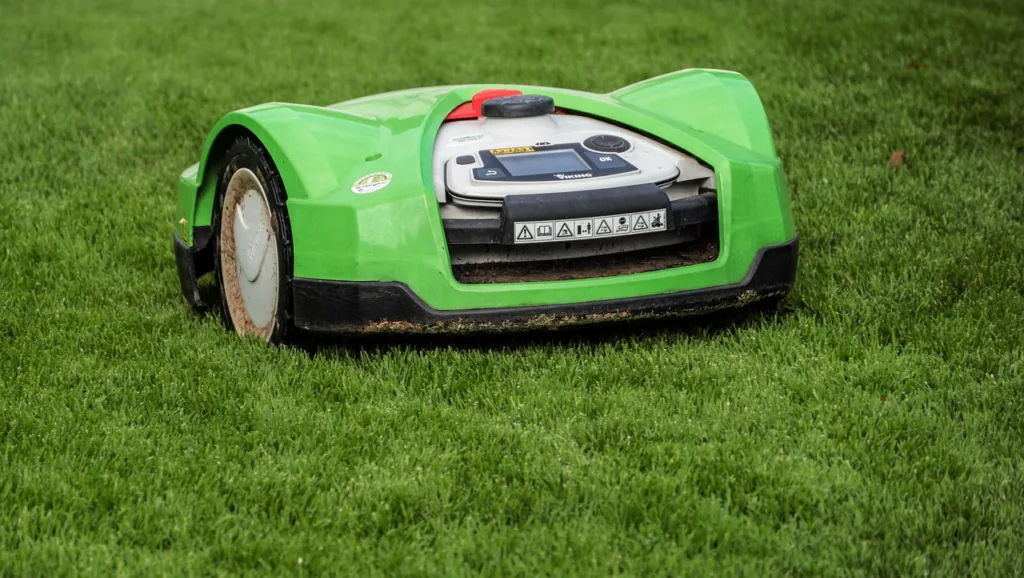
🚑 Better For Lawn Health
A robotic mower adopts a regular mowing schedule, making an appearance every two-to-three days on average to cut your grass. This is to prevent the grass from ever growing long enough to overwork the mower’s motor, and it also has the advantage of being better for lawn health.
Cutting less off the grass leaf on a regular basis is better than waiting several weeks, then cutting off more than half of the blade, which could stress the grass and cause the ends to turn yellow.
Regular mowing also encourages grass to grow thickly and stunts weed growth, making the grass more hard-wearing.
Plus, robotic mowers leave grass clippings on your lawn as they mow. These small, cut-up grass blades decompose over time and acts as a natural fertilizer, improving soil texture and content and reducing thatch and diseases. The result? Greener, healthier grass with no effort from you.
🎧 Quieter Than Other Mowers
Robotic mowers have quieter motors than traditional mower models, with a noise level of between 55 and 75 decibels on average.
In comparison, traditional lawnmowers with electric or petrol engines run at 80 to 100 decibels – that’s up to eight times louder than normal conversation volume.
If you live in a semi-detached or terraced house or you’re just mindful of the close proximity of your neighbours, a robotic mower is far less of a disturbance than a traditional mower.
Some robotic lawn mowers have such effective sound muffling technology that they can even be used during antisocial hours, such as early in the morning, without disturbing the peace.
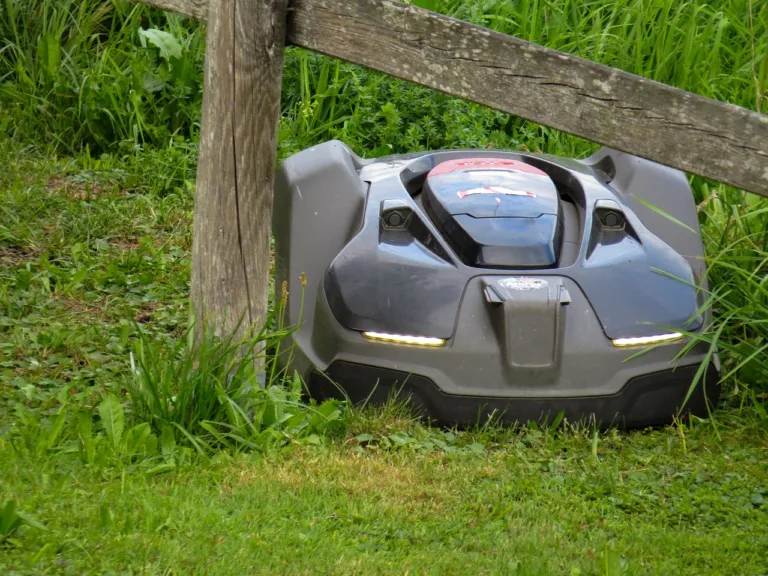
🗑 No Lawn Waste
Another big benefit of robotic mowers is that they don’t produce any lawn waste.
Because they mow regularly, robot lawnmowers produce only a small volume of grass clippings with every mow. These clippings can be left on the lawn and will decompose in a matter of days.
If you’re fed up with filling your garden waste bin or piling your compost heap high with grass cuttings, a robotic lawnmower will eliminate your need to do this.
♻️ Emission-Free Mowing
Robotic mowers are battery-operated, meaning that they use power from a battery to drive the blades and the motor.
A robotic mower is emission-free because it doesn’t use petrol, so it doesn’t emit toxic fumes as you mow.
If you’re keen to make environmentally-friendly choices with your garden tools and machinery, a robotic mower is a great alternative to a petrol-powered mower.
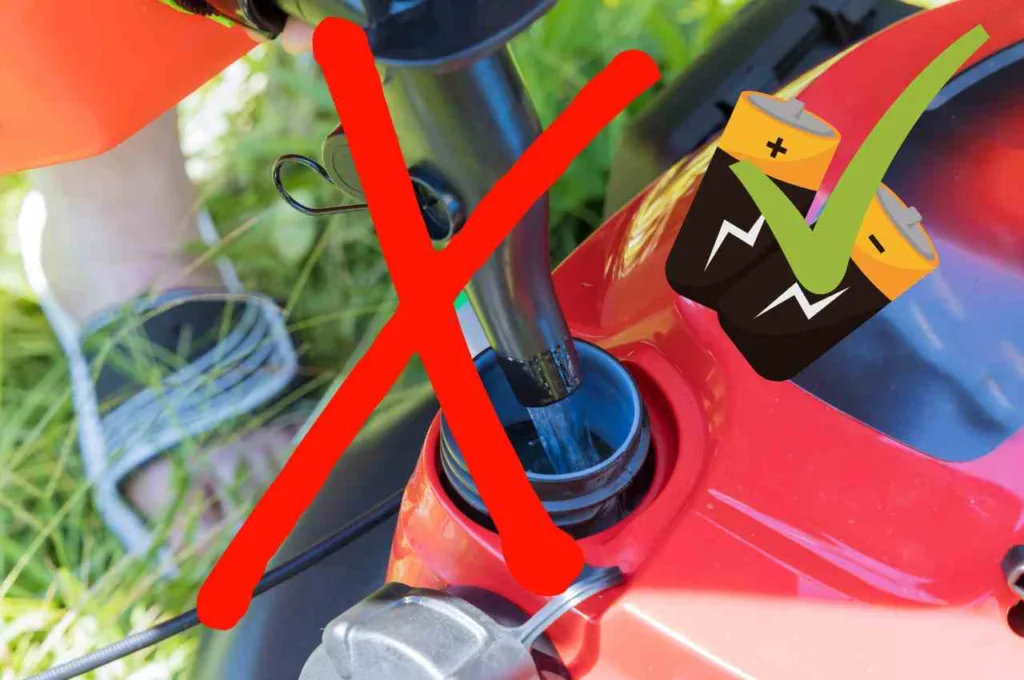
🔍 Consistent Mowing
Staying on top of your lawn mowing is a big commitment – and sometimes, when life gets in the way, it’s a difficult commitment to keep.
A great perk of a robotic mower is that it keeps your lawn short and tidy at all times, regardless of whether you’re tied up with work commitments, distracted by a big life event, or away from home for a few weeks on a much-needed holiday.
Robotic mowers are autonomous, so they’ll take care of your lawn mowing duties for you. Cutting grass is no longer your responsibility – so even if the rest of your life falls into momentary chaos, your lawn will remain immaculate.
👷 Equipped With Safety Features
A robotic mower is safe to use if you have pets or young children. In fact, due to its smaller size and independent operation, this mower type is safer than a conventional full-size push mower.
Robotic mowers have built-in safety features that prevent them from posing a danger to any human or pet within the operating vicinity.
One of the key safety features is the mower’s sensors, which detect objects and prompt the mower to stop moving or change direction to avoid collisions.
A robotic mower will also cut off if it’s lifted, preventing harm caused by the spinning blades, and most mowers will also sound an alarm to alert other people in the area.
Plus, because they’re positioned close to the ground, robotic mowers have a low centre of gravity, meaning that they’re unlikely to topple over when mowing on hills, slopes, or bumpy ground.
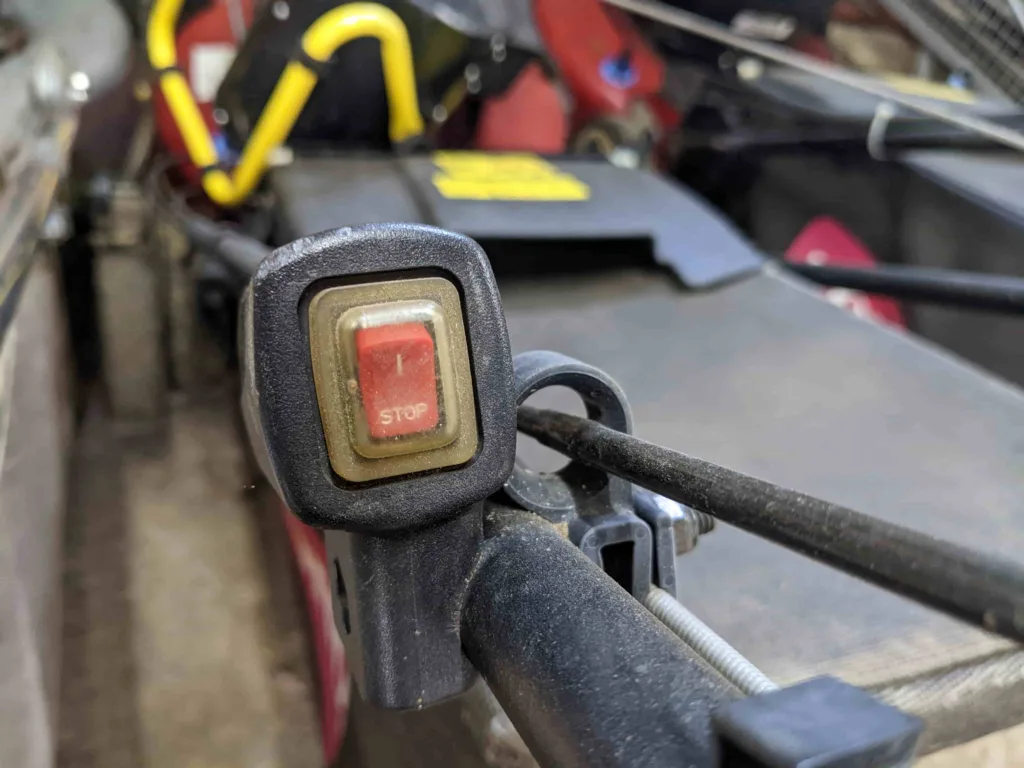
👴 Suitable For People With Mobility Restrictions
Finally, because of the lack of physical effort involved in owning a robotic mower, this mower type is ideal for people with disabilities or mobility restrictions.
If you’re over the age of 60, you have arthritis, you’re prone to back or shoulder strain, or you have a disability that affects your capacity to mow with a push mower, a robotic mower could be the ideal solution for you.
Most models work independently. All you need to do is clean the mower and replace the blades as recommended by the manufacturer – two responsibilities that aren’t physically demanding.
Even if you’re not up to the physical task of pushing a full-size mower, you may be able to handle a few smaller mower maintenance tasks.
❌ Robot Lawn Mower Cons
Like any mower type, robotic lawnmowers have their fair share of setbacks. Here’s what you should know about the disadvantages of owning a robot lawn mower:
💳 Expensive Upfront Cost
The biggest setback of a robotic lawn mower is that it’s significantly more expensive than a normal mower.
The average price of a domestic electric mower is £75-£150. A petrol mower costs around £175-£250, and a manual mower costs as little as £65.
Robotic lawnmowers, on the other hand, cost £350-£600 on average, depending on the mower features and the lawn size that it’s capable of cutting.
Even the more “basic” robotic mower models, with no WiFi compatibility or app connection, cost at least £300.
If your budget is small, you might be unable to buy a robotic mower simply because you can’t afford – or justify – the upfront cost.
I’m hoping that as robotic mowers become more popular and common, the price of these mowers drops down to a more budget-friendly figure.
⌨️ Require a Complex Setup
The process of programming and setting up a robotic mower is complex and time-consuming, so this is another setback of owning this type of mower.
Setting up a robotic mower involves laying a boundary wire around your lawn, installing guide wires to and from the charging station, inputting your settings into the mower’s interface, and (for WiFi mowers) downloading an app and connecting the mower to your account.
You’ll need to find a suitable place for the charging station and anchor the boundary and guide wires into the grass with screws or hooks – or bury them below your grass, which takes a bit of work to get right. Folks with complex gardens will have to follow a more complex setup process because the perimeter wire has to be placed around the entire garden and all obstacles on the lawn.
You might also want to amend the mower’s settings to suit your mowing preferences, such as changing the schedule, or amending the date, time, or language.
If you’re not super familiar with tech, you might not like the idea of having to commit to these additional steps in order to get your mower up and running.
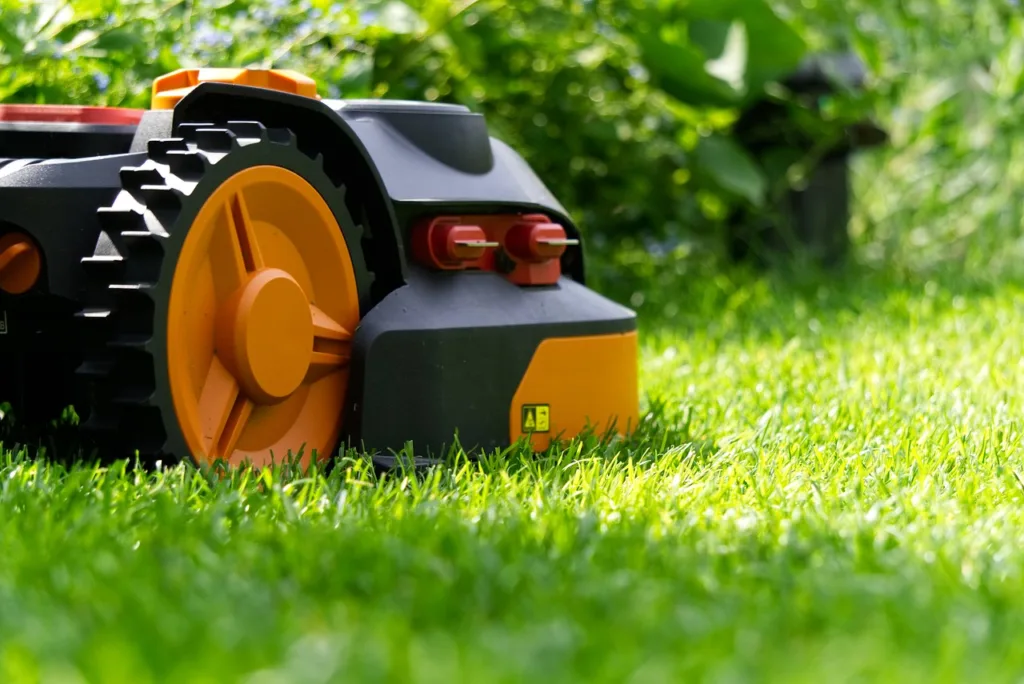
🛠 Higher Maintenance
Although robotic lawnmowers can be left to do their own thing as far as lawn mowing is concerned, maintaining these mowers takes more effort compared to a traditional mower model.
Because a robotic mower cuts your lawn more frequently (around twice or three times per week), the mower will need to be cleaned more often than a conventional mower.
You’ll also need to replace the mower’s blades after every 3 months or so, while a conventional mower blade lasts for years and only needs to be sharpened once or twice per mowing season.
Plus, robotic mowers are more complex machines than traditional push mowers, so they may occasionally encounter technical issues that require a system reset and perhaps a reprogramming.
There are other aspects of the mower setup that could also be compromised, resulting in extra work to resolve the problem. For instance, a perimeter wire could break, and your mower would be out of use until you’d bought a replacement line.
🔋 Restricted By Battery Life
A robotic lawnmower uses a rechargeable battery, which, depending on your lawn size, may be restrictive.
Robotic mowers can only be out on your lawn while they have enough battery juice to power the blades.
When the mower senses its battery life is running low, it’ll return to the charging station for a recharge. That might mean your mower has to cut your lawn in separate intervals, with charging in between.
You’ll still end up with a fully mown lawn at the end, but it’ll take longer for your mower to achieve the intended result.

✂️ Hit-And-Miss With Edge-Cutting
Most robotic mowers are unable to cut all the way to the edge, which is another disadvantage of this mower type’s performance.
A robotic lawnmower is designed to put a certain distance between the mowing unit and the body, primarily for safety, since it allows the mower some maneuvering room if a foreign object (like a foot) ends up in its path.
Because of this, a robotic mower can only completely mow your lawn from edge to edge if it has enough room to move beyond the edge of your lawn. This might not be possible if your lawn edge meets an obstacle, like a flower bed, a hedge, or a fence.
Depending on the design of your garden and your placement of the boundary wire, you may have to strim or cut the edges of your lawn from time to time if your robotic mower is unable to do it.
The alternative is to look for a robotic mower that can mow around the outside of the boundary wire, enabling edge cutting, but this isn’t a popular feature in most current models.
🍂 Can’t Mow Over Twigs Or Leaves
Robot lawnmowers are smaller and have less powerful motors and more delicate blades than conventional rotary mowers. They may struggle if they’re used on lawns with a lot of twigs and leaves, which could clog the blades and wear out the motor.
You can still use a robotic lawnmower if your lawn is prone to accumulating debris, but you’ll need to rake your lawn regularly to prevent a buildup of items that could compromise your mower’s performance.
Cutting wet grass is also out of the question if you own a robot mower, since water could cause the mower’s circuit to burn out – and that’s not the sort of thing that your warranty will cover.
So, you’ll need to make sure your mower doesn’t head out on wet days (you shouldn’t be cutting wet grass regardless of the mower type you have, so this isn’t necessarily a disadvantage of robotic mowers only). Most robotic mowers have rain sensors that will stop them from going out on your lawn in the wet weather.

📦 Don’t Collect Grass
As I mentioned in the pros section, robotic mowers don’t collect grass like most traditional mowers – they deposit the grass clippings on the lawn as they mow.
This is because of the design of this mower type. Robotic mowers are small, compact, and space-saving, with no room for a large, bulky grass box and no practical means of emptying the box during mowing.
Mulching has numerous benefits for grass health, but you might not like the look of grass clippings scattered across your lawn (even if they’re quick to decompose).
In this case, you will need to rake up the dead grass and dispose of it yourself after every appearance from your robotic lawnmower.
While this isn’t a big job compared to the physical act of pushing a lawn mower back and forth across your garden, if you hate mowing and everything about it, it might be a job too much for you.
🔁 Can’t Mow Lawn Stripes
Another similar disadvantage of a robotic mower’s performance is that you can’t use this mower to create a striped lawn.
Most robotic mowers are unable to mow a lawn in straight lines. Instead, they mow in a random pattern, covering every section (and sometimes revisiting sections multiple times) until all your grass is cut.
Imagine the chaos if a robotic mower with a rear roller was left to its own devices on your lawn. You’d end up with stripes in all directions – not the neat back-and-forth stripes of a push-powered mower.
So, if you specifically want a mower that you can use to achieve a beautifully striped lawn, a robotic mower isn’t the right choice for you.

👮♂️ Risk Of Theft
Finally, robotic lawn mower technology is expensive – and unfortunately, opportunist thieves know this.
A robotic mower sits in a charging station on your lawn when it’s not in use. You can’t barricade this expensive machine in your shed or outhouse, as you could with a traditional mower, because the mower has to be able to get out on your lawn according to its mowing schedule.
That means you have no choice but to leave your mower on display, which – coupled with the fact that robotic mowers are smaller and therefore easier to steal – puts them at a higher risk of theft.
Thankfully, the best higher-end robotic lawn mowers have several features that should deter thieves or help you to react accordingly if your mower is stolen, such as an alarm that sounds when the mower is lifted, and GPS tracking – but they don’t eliminate the risk of theft entirely.
📊 Pros And Cons Of Robot Lawn Mowers Chart
| Pros of Robot Lawn Mowers | Cons of Robot Lawn Mowers |
|---|---|
| Save Time And Effort | Expensive Upfront Cost |
| Cheaper To Run Than Other Mowers | Require a Complex Setup |
| Better For Lawn Health | Higher Maintenance |
| Quieter Than Other Mowers | Restricted By Battery Life |
| No Lawn Waste | Hit-And-Miss With Edge-Cutting |
| Emission-Free Mowing | Can't Mow Over Twigs Or Leaves |
| Consistent Mowing | Don't Collect Grass |
| Equipped With Safety Features | Can't Mow Lawn Stripes |
| Suitable For People With Mobility Restrictions | Risk Of Theft |
Overall Recommendation: Robot mowers are worth it for those with big budgets who want to say goodbye to manual lawn mowing. They are especially suitable for people with mobility restrictions. However, if you have a smaller budget and prefer a simpler setup and maintenance, consider a push rotary mower instead.
💵 Are Robot Lawn Mowers Worth It?
You should now have a clear idea of the benefits and setbacks of owning a robot mower. From here, you can weigh up the pros and cons and decide whether or not robotic lawnmowers are worth the initial investment based on your personal preferences.
In our opinion, robot mowers are definitely worth it for folks with big budgets who want to wave goodbye to their manual lawn mowing duties for good. A robotic lawn mower is especially worth it if you’re over 60 or have mobility restrictions that prevent you from being able to comfortably or safely mow your lawn with a conventional push mower.
However, if you have a smaller budget that simply can’t stretch to an expensive robot mower, and you don’t like the idea of the complex setup and maintenance involved in owning this mower type, I recommend considering a push rotary mower instead, which is more affordable and easier to maintain.
I think there are a few features of a robotic mower’s performance that manufacturers still need to iron out. In a few years’ time, we’ll probably have the choice of robotic mowers with better capabilities and fewer setbacks – so our updated cons list will be a lot shorter!
